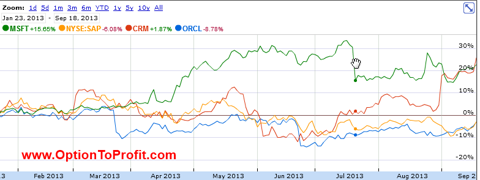 “There’s always a calm before the storm” is a fairly well known saying that doesn’t always accurately define a sequence of events.
“There’s always a calm before the storm” is a fairly well known saying that doesn’t always accurately define a sequence of events.
Are all storms preceded by a period of calm? Is calm always followed by a storm?
The predictive capability of a period of calm hasn’t necessarily been validated among meteorological circles.
Being a meteorologist, however, is very similar to being a stock analyst or a market technician. No one really expects you to get it right, because you get it wrong so often. Besides, you would have to be a fool to fully predicate your actions on their prognostications. Neither group tends to publicly sit down and review the signals that had them sending the wrong messages.
Other than that meteorologists often get their wardrobes provided at no cost, while market analysts often get unlimited supplies of antacids. Meteorologists, though often wrong, are still very often beloved by their audience. I’m not certain the same can be said for stock analysts.
This past week was a forgettable one in just about all aspects. It was a week of calm, at least as far as potentially market moving news tend to go. Yet even in the midst of a sea of calm, the market was down over 1% and was unable to hold the 1700 level on the S&P 500, bringing us back to a level last seen about 10 days ago, when all was sunny.
While meteorologists often look to macro events, such as “El Nino,” or even global warming, the macro events that may move our markets are many and varied, but none seem to have paid a call this week. In fact, even factors that in the past sent chills of fear and uncertainty into the hearts of investors, such as a government shutdown or impending default on US obligations, have thus far barely elicited a yawn.
The perfect storm of good news and absence of bad news has simply continued. Aalthough this week was one of relative calm it’s hard to not notice dark clouds on the horizon, most of which are preceded by the fear of “what if.” What if tapering begins? What if the government is shut down? What if there is a government default?
Maybe that’s why Goldman Sachs (GS) just recommended the use of portfolio protective puts and that sentiment was quickly echoed by many that had access to a microphone. Coming in advance of the beginning of the new earnings season it reminds us that the just completed earnings season had few reasons to believe that growth was the trend at hand.
Of course, one could also be of the opinion that with everyone rallying to secure their protective puts this could be the perfect time to prepare for another market move higher.
In an effort to hedge the hedge, I am continuing to keep my cash reserves at relatively high levels but am still confident that with each week there are reasonably attractive trades that have a degree of safety and can create current income streams to help offset any market weakness.
If there is calm ahead, I prefer to look for stocks this week that are somewhat boring and have been trading in a reasonably narrow range. That kind of calm is just the tonic for covered option strategies.
This week the potential stock selections are restricted to the “Traditional” category, as no appealing choices were found in the Double Dip Dividend, Momentum and “PEE” categories this week (see details).
On an otherwise bad day to end the week, Microsoft (MSFT) danced to its own drummer, as Steve Ballmer, the outgoing CEO performed one of his characteristic morale raising dances at what is likely to be the final annual company wide meeting at which he presides. Reportedly, the day’s bump in share price came as the rumor regarding Ford (F) CEO Alan Mulally made the rounds indicating that his interest in assuming the position at Microsoft was strengthening. While it seems difficult to understand the synergy it may simply be another example of the market’s appetite for an anti-Ballmer. But without regard to immediate stories regarding transition in leadership, Microsoft just continues to offer a good combination of option premiums and dividends at this level, as it further commits itself toward creating its own ecosystem, perhaps not with an eye on increasing marketshare, but rather on retaining the loyalty of customers who might otherwise feel the lure of the competition.
While it was a good day for Microsoft it wasn’t a very good day for Intel (INTC). While the past years have seen close correlation between the fortunes of Intel and Microsoft, they certainly diverged this week. Part of the reason was some concern regarding a delay in the start of “Intel TV,” a web based television service which was thought to be a remedy for its poorly diversified revenue sources. Intel has demonstrated some resilience in the $22.50 range and like Microsoft offers a good combination of option premiums and dividends.
I liked Dow Chemical (DOW) enough to buy it last week in the hopes of capturing its dividend and option premium. However, a late afternoon spike in its share price right before going ex-dividend resulted in early assignment of shares. Following Friday’s sharp price decline, it”s right back to where it started. Still attractive, but without the dividend. It stands in sharp distinction to many of the companies that I’ve been considering over the past two months in that it s current share price is higher than where it stood at a recent market top on May 21, 2013 when the market reacted to FOMC minutes and a Ben Bernanke press conference by embarking on a quick 4% decline.
While I liked Deere (DE) last week and almost always find myself liking it, I didn’t purchase shares last week in an attempt to capture the dividend. Sometimes, especially for stocks above $50 the nearest strike prices are too far away from the current share price to offer a premium that offers sufficient reward for the risk undertaken. That was the case last week. However, if the lower prices to close the week hold at the open of this week and remain near the strike, I think the timing may be just right to add shares of Deere.
As far as boring stocks go, Mondelez (MDLZ) is boring in everything other than its name. Even Nelson Peltz’s self-serving attempts to move share price by discussing why he believed it was an ideal take-over target for Pepsi (PEP) did nothing to stir share price in any meaningful or sustained way. That kind of price stability is ideally suited for a covered option strategy.
Retail has been a difficult sector recently, especially teen retail. However, just as Mondelez can make boring become interesting, so too can The Gap (GPS) make boredom the new chique. Well down from a brief earnings fueled rise, shares appear to have support at the $40 level and won’t face the challenge of earnings until mid-way through the November 2013 option cycle. In the interim, it also goes ex-dividend during the October 2013 cycle.
Following its recent earnings related drop Darden Restaurants (DRI) is trading at a much more appealing level. From a covered option trader’s perspective the strike prices below the $50 level, graduated in single dollars is much more attractive and offers many more opportunities than the sparser ones available above $50. While Darden may also be a boring kind of pick it’s interest level is also enhanced by a very nice dividend that comes during the October cycle.
Finally, Barclays (BCS) may have qualified as a “Momentum” selection based on its recent price movements but once the dust settles it should start trading in a more sedate manner. In addition to various legal worries and the backdrop of lethargic European economies, Barclays recently announced the need to meet increased capital reserve requirements. Doing so through the issuance of stock is never a great way to see shares appreciate. However, the issuance of “rights” to existing shareholders entitling them to purchase shares at approximately a 40% discount helped to drive up share price
Traditional Stocks: Barclays, Deere, Darden, Dow Chemical, Intel, Microsoft, Mondelez, The Gap
Momentum Stocks: none
Double Dip Dividend: none
Premiums Enhanced by Earnings: none
Remember, these are just guidelines for the coming week. The above selections may be become actionable, most often coupling a share purchase with call option sales or the sale of covered put contracts, in adjustment to and consideration of market movements. The over-riding objective is to create a healthy income stream for the week with reduction of trading risk.

 Generally, when you hear the words “perfect storm,” you tend to think of an unfortunate alignment of events that brings along some tragedy. While any of the events could have created its own tragedy the collusion results in something of enormous scale.
Generally, when you hear the words “perfect storm,” you tend to think of an unfortunate alignment of events that brings along some tragedy. While any of the events could have created its own tragedy the collusion results in something of enormous scale.  Maybe I belong to a different generation, but I have certain expectations regarding behavior and responsibility, especially when other’s are your subordinates and maybe even extending to your shareholders.
Maybe I belong to a different generation, but I have certain expectations regarding behavior and responsibility, especially when other’s are your subordinates and maybe even extending to your shareholders.


 How much is enough?
How much is enough?
